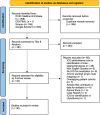How effective is indocyanine green (ICG) in localization of malignant pulmonary nodules? A systematic review and meta-analysis
- PMID: 35959126
- PMCID: PMC9357917
- DOI: 10.3389/fsurg.2022.967897
How effective is indocyanine green (ICG) in localization of malignant pulmonary nodules? A systematic review and meta-analysis
Abstract
Background: Video-Assisted and Robotic-Assisted techniques become constantly more prominent practice in thoracic surgery for lung cancer. Furthermore, the increased frequency in detection of small lung cancers makes the intra-operative identification of these cancers even more challenging. Indocyanine Green (ICG) is one of the most commonly used dyes that assists surgeons identify small lung cancers intra-operatively. Our study aimed to evaluate the effectiveness and safety of ICG in lung cancer detection.
Methods: We performed a systematic review of the literature by screening the databases of MEDLINE, EMBASE, CENTRAL and Scopus until 30th April 2022 and the first 300 articles of Google Scholar for any suitable grey literature. We included any study that investigated the effectiveness of ICG in lung cancer detection. We excluded studies that explored the use of ICG only in identification of intersegmental planes, lymph node mapping, case reports and non-English articles. We aimed to perform a meta-analysis on test accuracy studies using hierarchical summary receiver operating characteristic (HSROC) and the bivariate random-effects models. In cases where the data for a localization technique was not sufficient for that analysis, it was presented with tables with narrative purposes. Each study was assessed for Risk of Bias (RoB) and Applicability using the QUADAS-2 tool.
Results: We found 30 eligible studies that included a total of 1,776 patients who underwent ICG localization of pulmonary nodules. We identified three ICG localization techniques: CT-guided, endobronchial and intravenous. From the 30 studies, 13 investigated CT-guided localization, 12 explored an endobronchial method while 8 studies administered ICG intravenously the median reported success rate was 94.3% (IQR: 91.4%-100%) and 98.3% (IQR: 94%-100%) for the first two techniques respectively. Intravenous ICG lung cancer localization showed Sensitivity of 88% (95% CI: 59%-0.97%) and Specificity of 25% (95% CI: 0.04%-0.74%). There were 15.2% (150/989) patients who experienced complications from CT guided ICG localization. No ICG-related complications were reported in endobronchial or intravenous techniques.
Conclusion: Our study provides a comprehensive review of the literature on ICG localization techniques for lung cancer. Current evidence suggests that ICG is boh effective and safe. Further prospective research with standardized protocols across multiple thoracic units is required in order to accurately validate these findings.
Keywords: ICG; Indocyianine green; lung malignancy; lung surgery; pulmonary nodules.
© 2022 Gkikas, Lampridis, Patrini, Kestenholz, Scarci and Minervini.
Conflict of interest statement
The authors declare that the research was conducted in the absence of any commercial or financial relationships that could be construed as a potential conflict of interest.
Figures



Similar articles
-
Advantages and rational application of indocyanine green fluorescence in pulmonary nodule surgery: a narrative review.J Thorac Dis. 2024 Oct 31;16(10):7192-7203. doi: 10.21037/jtd-24-1502. Epub 2024 Oct 30. J Thorac Dis. 2024. PMID: 39552905 Free PMC article. Review.
-
Electromagnetic navigation bronchoscopic localization versus percutaneous CT-guided localization for thoracoscopic resection of small pulmonary nodules.Thorac Cancer. 2021 Feb;12(4):468-474. doi: 10.1111/1759-7714.13775. Epub 2021 Jan 4. Thorac Cancer. 2021. PMID: 33398925 Free PMC article.
-
[Diagnostic value of optical imaging combined with indocyanine green-guided sentinel lymph node biopsy in gastric cancer: a meta-analysis].Zhonghua Wei Chang Wai Ke Za Zhi. 2019 Dec 25;22(12):1196-1204. doi: 10.3760/cma.j.issn.1671-0274.2019.12.017. Zhonghua Wei Chang Wai Ke Za Zhi. 2019. PMID: 31874538 Chinese.
-
Diagnostic value of near-infrared or fluorescent indocyanine green guided sentinel lymph node mapping in gastric cancer: A systematic review and meta-analysis.J Surg Oncol. 2018 Dec;118(8):1243-1256. doi: 10.1002/jso.25285. Epub 2018 Oct 31. J Surg Oncol. 2018. PMID: 30380146
-
Preoperative computer tomography-guided indocyanine green injection is associated with successful localization of small pulmonary nodules.Transl Lung Cancer Res. 2021 May;10(5):2229-2236. doi: 10.21037/tlcr-21-425. Transl Lung Cancer Res. 2021. PMID: 34164272 Free PMC article.
Cited by
-
Advantages and rational application of indocyanine green fluorescence in pulmonary nodule surgery: a narrative review.J Thorac Dis. 2024 Oct 31;16(10):7192-7203. doi: 10.21037/jtd-24-1502. Epub 2024 Oct 30. J Thorac Dis. 2024. PMID: 39552905 Free PMC article. Review.
-
Computed tomography-guided localization of pulmonary nodules prior to thoracoscopic surgery.Thorac Cancer. 2023 Jan;14(2):119-126. doi: 10.1111/1759-7714.14754. Epub 2022 Dec 8. Thorac Cancer. 2023. PMID: 36482812 Free PMC article. Review.
-
Whole-body fluorescence cryotomography identifies a fast-acting, high-contrast, durable contrast agent for fluorescence-guided surgery.Theranostics. 2024 Oct 7;14(17):6426-6445. doi: 10.7150/thno.100802. eCollection 2024. Theranostics. 2024. PMID: 39479457 Free PMC article.
-
Computed tomography-guided hookwire localization and medical glue combined with methylene blue localization for pulmonary nodules before video-assisted thoracoscopic surgery: a single-center, retrospective study.Quant Imaging Med Surg. 2023 Sep 1;13(9):6228-6240. doi: 10.21037/qims-22-1240. Epub 2023 Aug 9. Quant Imaging Med Surg. 2023. PMID: 37711779 Free PMC article.
-
The effectiveness and safety of computed tomography-guided hook-wire localization for secondary video-assisted thoracoscopic surgery: a retrospective study.J Thorac Dis. 2024 Dec 31;16(12):8350-8362. doi: 10.21037/jtd-24-1342. Epub 2024 Dec 27. J Thorac Dis. 2024. PMID: 39831217 Free PMC article.
References
-
- Canadian Cancer Society. Lung cancer statistics. Available from: http://www.cancer.ca/en/cancer-information/cancer-type/lung/statistics/?...=on (Accessed June 4, 2022).
Publication types
LinkOut - more resources
Full Text Sources
Other Literature Sources
Miscellaneous

